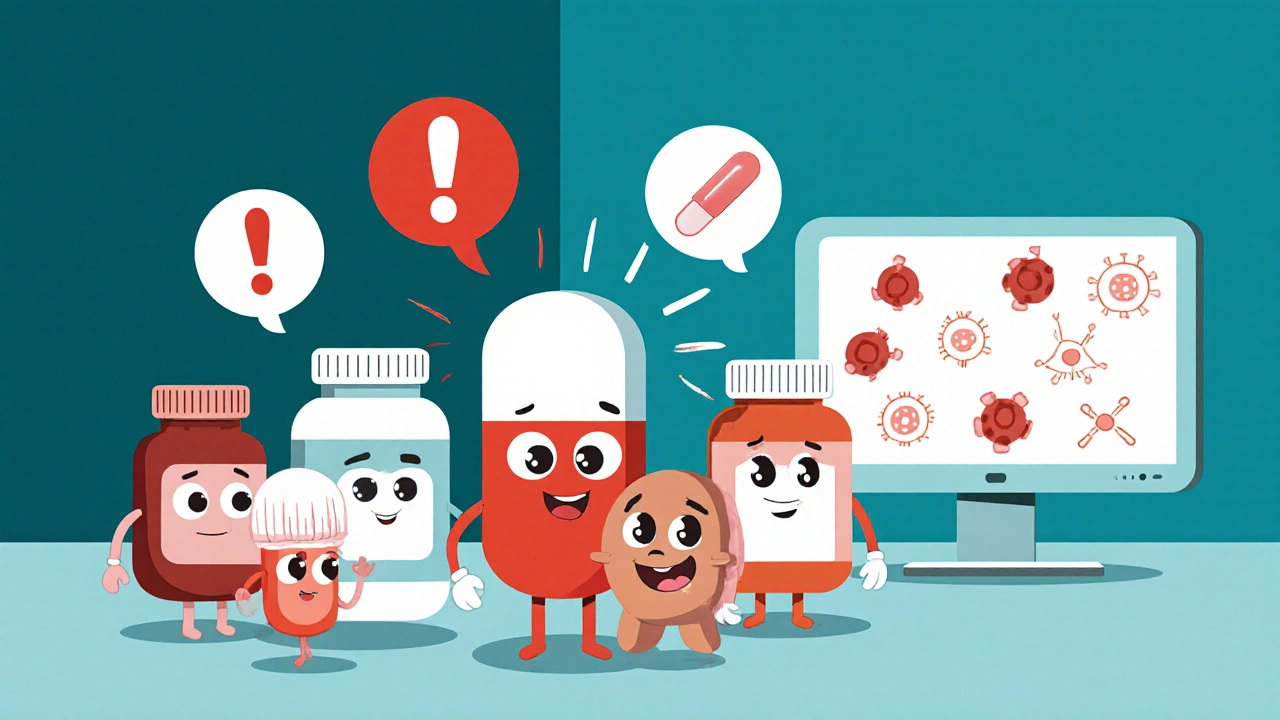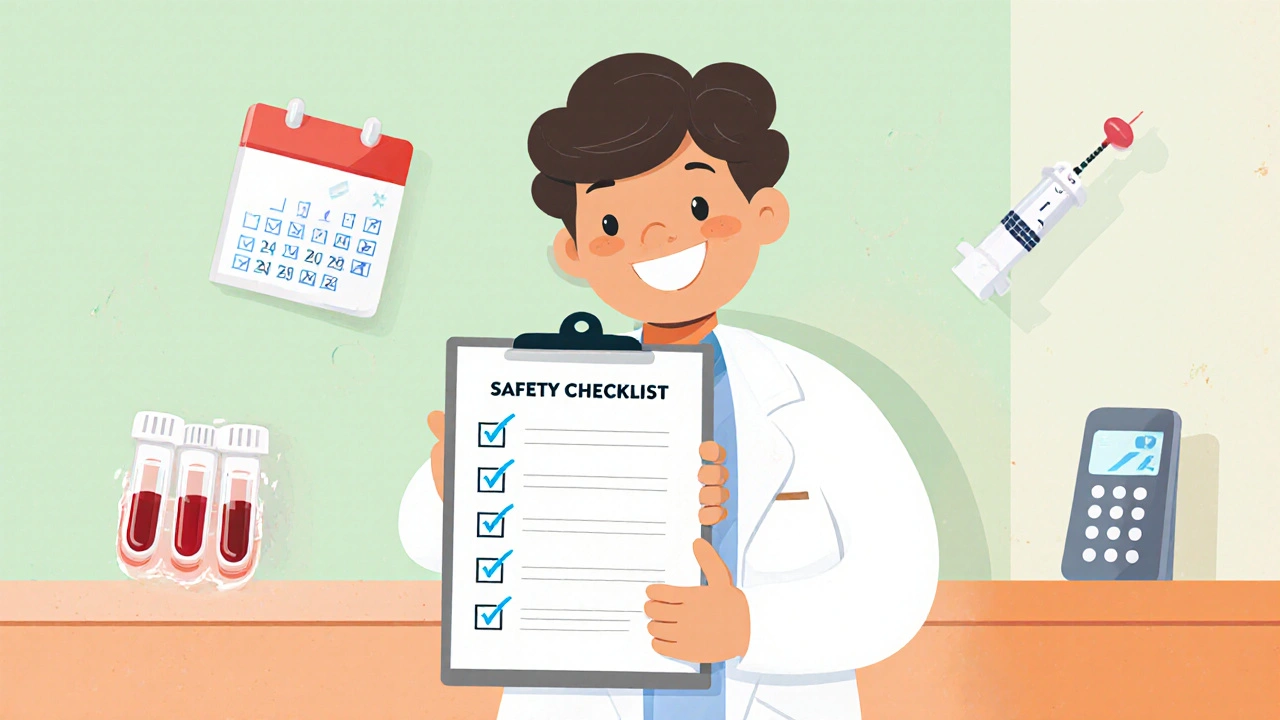Azathioprine Drug Interactions: Complete Guide & Safety Tips

Azathioprine Drug Interaction Checker
Check Your Azathioprine Interactions
Enter the medications and supplements you're currently taking to see if they interact dangerously with azathioprine.
When you’re on Azathioprine is an oral immunosuppressant used to prevent organ rejection and treat autoimmune diseases, the last thing you want is a surprise from another medication or even a food item. This guide breaks down the most common and dangerous interactions, shows how to spot red flags, and gives you a practical checklist so you can stay in control of your therapy.
Key Takeaways
- Azathioprine’s effect hinges on the enzyme TPMT; genetic testing can prevent toxicity.
- Allopurinol, warfarin, and certain antibiotics dramatically boost azathioprine levels.
- Live vaccines are contraindicated because azathioprine weakens the immune response.
- Regular blood monitoring (CBC, liver enzymes) catches problems early.
- Adjust dosages only under medical supervision - never self‑medicate.
How Azathioprine Works
Azathioprine is a pro‑drug that converts into 6‑Mercaptopurine inside the body. This metabolite interferes with DNA synthesis, slowing down rapidly dividing immune cells. The result is fewer attacks on your own tissues, which is why doctors prescribe it for conditions like rheumatoid arthritis, inflammatory bowel disease, and after organ transplants.
Why Interactions Matter
Because azathioprine rides on a narrow therapeutic window, even a modest change in its blood level can swing you from “therapeutic” to “toxic.” Toxicity often shows up as bone‑marrow suppression (low white cells, platelets) or liver injury. On the flip side, if another drug cuts azathioprine’s effect, you risk a flare‑up of the disease you’re trying to control.

Major Drug Interactions
Below are the high‑impact culprits you’ll see most often in prescriptions or over‑the‑counter aisles.
Allopurinol
Allopurinol is a xanthine oxidase inhibitor used to lower uric acid in gout patients. It blocks the enzyme that normally helps clear 6‑mercaptopurine, causing azathioprine levels to sky‑rocket. The usual recommendation: cut the azathioprine dose by 50 % when starting allopurinol, then monitor blood counts closely.
Warfarin
Warfarin is an oral anticoagulant that interferes with vitamin K‑dependent clotting factors. Azathioprine can increase warfarin’s effect, raising INR and bleeding risk. If you need both, doctors often check INR twice a week during the first month and adjust the warfarin dose accordingly.
Trimethoprim‑Sulfamethoxazole (TMP‑SMX)
Commonly known as Bactrim, this antibiotic can suppress bone marrow on its own. Pair it with azathioprine and the risk of severe neutropenia doubles. Many clinicians pause azathioprine for the 5‑7 day course of TMP‑SMX, especially in patients with already low white‑cell counts.
Methotrexate
Methotrexate is a folate antagonist used in low doses for autoimmune diseases and in high doses for cancer. When used together, both drugs suppress the bone marrow, compounding the risk of pancytopenia. Close CBC monitoring every 1‑2 weeks is the rule of thumb.
Non‑steroidal Anti‑Inflammatory Drugs (NSAIDs)
OTC pain relievers like ibuprofen or naproxen can irritate the stomach lining. Azathioprine already carries a modest risk of gastrointestinal upset, so combining them may increase ulcer risk. If you need an NSAID, use the lowest effective dose and consider a proton‑pump inhibitor for protection.
Rifampin
Rifampin is an antibiotic that induces liver enzymes, especially CYP3A4. It speeds up the breakdown of azathioprine metabolites, potentially lowering efficacy. Dose escalation of azathioprine (10‑20 % increase) may be required, but only after confirming therapeutic drug levels.
Live Vaccines
Because azathioprine dampens the immune system, live attenuated vaccines (e.g., measles‑mumps‑rubella, varicella, yellow fever) can cause actual infection. Current guidelines advise waiting at least 4 weeks after vaccination before restarting azathioprine, or using an inactivated vaccine instead.
Food, Supplements, and Lifestyle Factors
While drugs are the biggest culprits, certain foods and supplements can tip the balance.
- Alcohol: Heavy drinking adds liver stress, which may worsen azathioprine‑related hepatotoxicity.
- Vitamin C (high‑dose): Some lab data suggest it can increase 6‑mercaptopurine levels, though evidence is limited.
- Herbal products like St. John’s wort induce CYP enzymes and may lower azathioprine efficacy.
- Smoking: Nicotine induces certain liver pathways, potentially reducing azathioprine’s effect.
Managing Interactions: A Practical Checklist
- Ask your pharmacist for a full medication list, including OTCs and supplements.
- Check if you have a TPMT (thiopurine methyltransferase) test result. Low TPMT activity requires dose reduction.
- Schedule baseline labs: CBC, liver function tests (ALT, AST), and renal panel before starting azathioprine.
- After any new drug is added, repeat CBC and LFTs within 1‑2 weeks.
- Document any side‑effects (e.g., sore mouth, fatigue, easy bruising) and report them immediately.
- Never adjust the dose on your own - always get a clinician’s order.

Interaction Summary Table
| Drug | Interaction Type | Clinical Effect | Management Strategy |
|---|---|---|---|
| Allopurinol | Pharmacokinetic - enzyme inhibition | ↑ Azathioprine levels → marrow toxicity | Reduce azathioprine dose by 50 %; monitor CBC |
| Warfarin | Pharmacodynamic - additive anticoagulation | ↑ INR → bleeding | Frequent INR checks; adjust warfarin dose |
| Trimethoprim‑Sulfamethoxazole | Pharmacodynamic - bone‑marrow suppression | Severe neutropenia | Hold azathioprine during course; CBC monitoring |
| Methotrexate | Pharmacodynamic - additive marrow suppression | Pancytopenia | Close CBC; consider dose spacing |
| NSAIDs | Pharmacodynamic - GI irritation | Ulcer risk | Use lowest dose; add PPI if needed |
| Rifampin | Pharmacokinetic - enzyme induction | ↓ Azathioprine efficacy | Consider azathioprine dose increase; monitor disease activity |
| Live Vaccines | Pharmacodynamic - immune suppression | Risk of vaccine‑derived infection | Avoid live vaccines; use inactivated alternatives |
When to Call Your Doctor
If you notice any of the following, seek medical attention right away:
- Fever, sore throat, or persistent cough (possible infection)
- Unexplained bruising or prolonged bleeding
- Yellowing of skin or eyes (liver trouble)
- Severe nausea, vomiting, or abdominal pain
Early intervention usually prevents a full‑blown crisis.
Frequently Asked Questions
Can I take ibuprofen for occasional pain while on azathioprine?
Yes, but keep the dose low and limit use to a few days. Pair it with a proton‑pump inhibitor if you need it frequently, and watch for any stomach upset.
Do I need regular blood tests for the whole time I’m on azathioprine?
Yes. Most doctors order a CBC and liver panel every 2‑4 weeks for the first three months, then every 2‑3 months once you’re stable.
Is it safe to get the flu shot while taking azathioprine?
The inactivated flu vaccine is safe and actually recommended because it protects you without the infection risk that comes with live vaccines.
My doctor wants to start me on allopurinol for gout. What should I do?
Tell the prescriber you’re on azathioprine. The usual plan is to halve the azathioprine dose, then check your blood count after a week. Adjustments are made based on those results.
Can herbal supplements like St. John’s wort affect azathioprine?
Yes. St. John’s wort induces liver enzymes that can lower azathioprine levels, potentially reducing its effectiveness. It’s best to avoid it or discuss alternatives with your doctor.
Understanding how azathioprine interacts with other drugs and lifestyle choices empowers you to stay healthy while reaping the medication’s benefits. Keep this guide handy, share it with anyone involved in your care, and never hesitate to ask a pharmacist or physician when a new drug is added to your regimen.

8 Comments
If you’re on azathioprine, you have a responsibility to keep your labs on schedule and never ignore a warning sign.
That’s the spirit-sharing this checklist with friends can keep everyone safer.
Never skip the INR checks when you mix warfarin with azathioprine, the bleeding risk spikes fast.
I appreciate the thoroughness of the guide; it reminds us that medication management is as much an art as a science. While the tables list the culprits, the real challenge lies in staying vigilant amid daily life. Keeping a pocket notebook of every new drug or supplement can be a lifesaver. Remember, every lab draw is a dialogue between you and your physician, not a bureaucratic chore. In short, treat your regimen with the respect you’d give a delicate instrument.
Did you ever notice how big pharma seems to push these “essential” combos, like they’re hiding something,??? The more you dig, the clearer it becomes that the interaction tables are just a smokescreen,!!! Keep your eyes peeled, and don’t trust anything without a second opinion,!!!
Okay, let’s break this down step by step because there’s a lot to cover and you deserve a clear path forward.
First, write down every prescription, over‑the‑counter pill, and supplement you’re taking, even that occasional vitamin C you grab at the grocery store.
Second, schedule a baseline blood panel before you start any new drug – CBC, liver enzymes, and if you can, a TPMT test.
Third, if your doctor adds something like allopurinol, tell them you’re on azathioprine right away; they’ll usually cut the dose in half and set a follow‑up CBC in a week.
Fourth, when you’re on warfarin, keep a log of your INR values; a sudden jump could mean the azathioprine is amplifying the anticoagulant effect.
Fifth, with antibiotics such as Bactrim, pause azathioprine if your white count is already low – the combo can double the risk of neutropenia.
Sixth, never self‑adjust doses based on how you feel; the immune system is sneaky and symptoms can lag behind lab changes.
Seventh, use the lowest effective NSAID dose and pair it with a proton‑pump inhibitor if you need it for more than a few days – that protects your stomach lining.
Eighth, steer clear of St. John’s wort and other herbal boosters; they crank up liver enzymes and can make azathioprine less effective, risking a flare‑up of your disease.
Ninth, limit alcohol intake, because the liver already works overtime breaking down the drug.
Tenth, keep vaccinations in mind – only inactivated vaccines are safe while you’re immunosuppressed.
Eleventh, if you ever feel unusual fatigue, bruising, or yellowing of the eyes, call your doctor immediately – these could be early signs of bone‑marrow or liver toxicity.
Twelfth, set reminders on your phone for lab appointments; consistency is key, especially in the first three months.
Thirteenth, bring a printed copy of this guide to every appointment so you and your pharmacist can double‑check interactions.
Fourteenth, discuss any new over‑the‑counter meds with your healthcare team before taking them – even something as simple as a cold remedy can matter.
Fifteenth, stay networked with others on azathioprine; peer support can alert you to real‑world issues that aren’t in the official literature.
By following these steps, you’ll keep a tight grip on your therapy and avoid the nasty surprises that can come from hidden drug interactions.
We owe it to ourselves to treat azathioprine with the respect it demands; cutting corners is simply unacceptable.
Listen up, friends from every corner – the power to stay safe lies in sharing knowledge, so circulate this guide far and wide and demand thorough monitoring from every doctor you see.